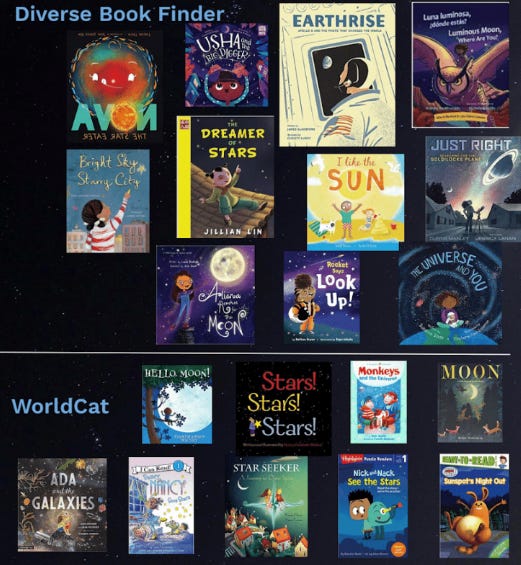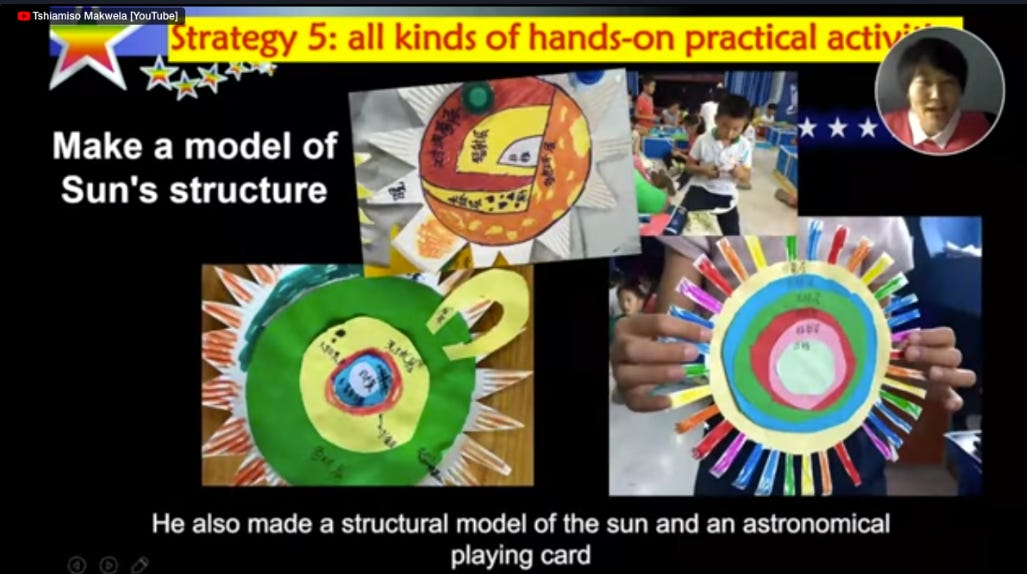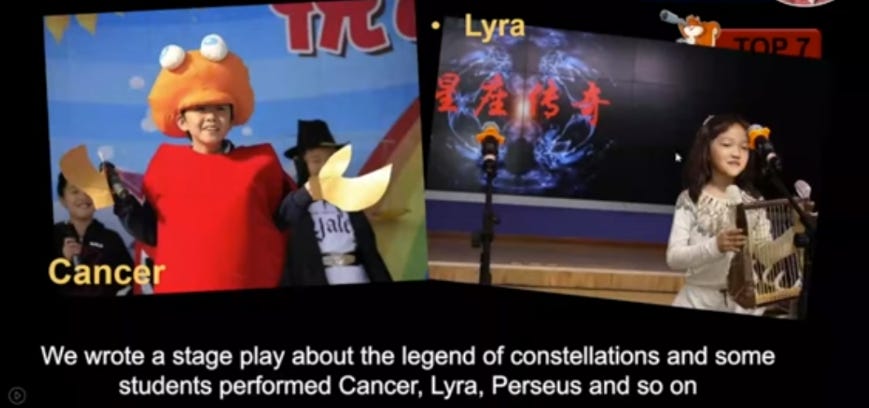TCA #39 - The 13 Ecliptic Constellations...Sizes, Borders, Dates; + 5 more [Nov. 21, 2022, Free Post]
Sky Lessons--Ecliptic Constellations Dates, Borders, Sizes; Connections--Powerpoints, Solar Galileoscopes, Light Echo Vid, Storybooks; 10 Primary School Strategies
Cover Photo - Zodiac Dates
In This Issue:
Cover Photo - Zodiac Dates
Welcome to Issue 39!
From the IAU Shaw Meeting, and Education To the 13 Ecliptic ConstellationsSky Lessons -
- Ecliptic Constellations Sizes and BordersConnections to the Sky
- Need Some Astronomy PowerPoints?
- Galileoscopes for the Upcoming Eclipses
- Light Echo Video from NASA
- IAU Shaw: Looking for Astronomy Storybooks? Look Carefully…Astronomical Teachniques
- IAU Shaw: Ten Strategies for a Successful Primary CurriculumThe Galactic Times InDepth Newsletter-Inbox Magazine and The Galactic Times #35 Highlights
Welcome to The Classroom Astronomer Newsletter-Inbox Magazine #39!
This is the free monthly issue of TCA. I have just finished virtually attending the IAU Shaw Astronomy Education Conference, organized out of Heidelberg, Germany (my European hometown!) and am busy organizing stories from that for the Premium Subscribers issue, intending to have that out around Thanksgiving.
I do want to note that the IAU Shaw conference, its fourth, was even better this year than last year’s. Better organized, better timed, and better performed in most aspects. One thing I found interesting was that some of the presentations were spoken entirely in a non-English language, but the slides in the presentations were entirely in English or were simultaneously in that language AND English and thus totally comprehensible to the global audience. Bravo!
But please put the Close Captions below the presentation slides and not hide names, URLS, contact information that are put on the slides, Hopin service….
- - -
In this issue is a look at that wonderful time of year when the Sun ‘leaves’ the traditional Zodiac and enters the 13th constellation, Ophiuchus! A fun time to teach the reality of astronomy versus the fake signs of astrology. In this case, not only can we talk about how precession has shifted the signs from thousands of years ago when they were created but we can use the Moon to find the 13 (actually, 14) constellations the Sun and Moon go through/touch, AND using the Moon, measure their approximate and unequal sizes—not all 30 ‘days’ in size!
Also, some interesting new resources that have come to my attention.
- - -
Key websites: Homepage for The Classroom Astronomer, with its index to all Inbox Magazine issues’ contents, by celestial object, educational subject area, grade level or venue, and with complete Tables of Contents:
https://www.classroomastronomer.com . Not a Full Paid Subscriber? Become one by putting your email in the box below (and then you’ll have access to the Archive of all past issues!). And see the Issue end for an upgrade offer!
The ultimate home of our Universe — Hermograph Press — has its homepage at: www.hermograph.com and its Store, for educational materials and books, at: www.hermograph.com/store .
- - -
Thanks for subscribing!
Publisher -- Dr. Larry Krumenaker
Sky Lessons
Ecliptic Constellations’ Sizes and Borders
Astrology. The astronomical equivalent of ‘fake news.’ Now comes the time of year that I most loooooooove…..especially as a misconception busting teacher.
The Sun crosses the border from Libra into the constellation of Scorpius on the 23rd. BUT!…it is only amongst those stars for….hold on….wait for it…..seven days. Yes, one week. Half a fortnight. The 23rd through 29th (Happy Thanksgiving, Scorpions!). Then… the Sun crosses the border into…..
Ophiuchus.
What? Huh? <Sounds of horoscope buffs rustling newspaper pages>
You don’t see this one in the newspaper horoscopes, do you? Not much future in being a handler of snakes, I guess. But astronomically, the Sun spends more time in THIS constellation than it does in the Scorpion! Almost 3 weeks.
The constellations of the zodiac are those star groups that the Sun’s path, the Ecliptic, goes through in the sky. And there are thirteen of them (and there’s actually one more that is sun-relevant, besides, see below). Ophiuchus, the handler of snakes and the celestial avatar of Aesculapius (spellings vary), the first doctor, has one foot pushing down on the back of Scorpius, so the Sun only goes through one of Scorpius’ narrow claws before our glowing orb exits the Scorpion after a week to enter the good Doctor. But 13 wasn’t a lucky number to the ancient Greeks, and 13 constellations don’t divide up the Ecliptic evenly, nor are they the same sizes, nor do they then match up with the 12 months (more or less formed by the 12 moon phase cycles—another ignored oopsy, calendrically). So Ophiuchus was ignored.
It also shows that if you, a human, make up completely artificial star patterns that have absolutely no reality in nature—human-made constructs—you have to be daft to expect them to have any real say or control over your life.
Sorta like fake news.
Oh, and as far as the Sun signs go, there are actually 14; the Sun, which isn’t a point but a disk of half a degree of size, encroaches over another constellation for about a day in March—Cetus the Sea Monster. We’ll talk about THAT then.
Which brings the question….how big ARE the zodiac/Ecliptic constellations and HOW can you show that to students?
There are two ways to do that:
First, let’s talk about the amount of time the Sun spends in them, i.e. their length in days.
Constellations are irregular shapes, and the Ecliptic is a tilted circle, inclined compared to the Earth’s north-south pole-to-pole—equator-based coordinate system normality. It rides high in some months, low in others, and doesn’t ‘go straight East or West’. Since the Sun *averages* just under ~1 degree per day of motion (but sometimes it is a tad more and others a tad less), 360 degrees of travel for 365.24 days, it is the time it takes between our man-made borders between the star groups that will define the sizes of the zodiac signs for our purpose. One COULD ask if this relates to square degrees of area but since the Sun doesn’t cross north to south, that is a fallacious point to make.
If you wanted 12 equal signs, you’d expect them all to be 360/12 or 30 degrees each. In days that would be 365.24/12 or 30.44 days average, a minor difference, right? In order from largest to smallest by days, here are the constellations of the Ecliptic:
45 days Virgo
38* Pisces
37 Taurus
37 Leo
32 Sagittarius
31 Gemini
25 Aries
24 Aquarius
23 Capricornus
23 Libra
20 Cancer
18 Ophiuchus
7 Scorpius
<1 Cetus
A total of 360*. The asterisk is because the Sun only spends part of a day in Cetus, and then only part of its disk is IN Cetus; on that day it is shared between Cetus and Pisces. And you have 6 constellations with a size of more than 30 days and 7 (not counting Cetus) with less than 30. Furthermore, the erstwhile traditional one, Scorpius, ranks not only last in size, but is lower on the list than Ophiuchus! Gemini is as close to “the average size” as an Ecliptic constellation gets—it rises just before midnight these nights. For 13 full signs, that really means the average ‘sign’ is 360/13 or 27.7 degrees in size. Doesn’t change anything in this ranking.
Can we visualize this? The fastest way would be with not the Sun but with the Moon.
We can follow the Moon through the constellations of the Ecliptic day by day noting in front of which stars it is. There is a caveat, though. The Moon’s orbit is tilted from the Ecliptic. It can actually range a tad over 5 degrees from it in our sky. As the irregular sizes of the constellations means it can have wider “East-West-ish” dimensions OFF the Ecliptic for the Moon’s path, that time the Moon spends in the constellation can vary slightly. Also, because the Moon has a considerably elliptical orbit, its speed isn’t constant. In fact, it is more variable in speed than the Earth’s orbit is, which also makes the Sun’s apparent speed vary accordingly, but not as variable as the Moon’s. But for illustrative purposes, we can manage.
The Moon has a sidereal rate to go once around the sky in 27.3 days—the number of days it returns to the starfield from where it began. That is NOT the number of days between identical phases—New to New or Full to Full—that’s 29.5 days, the synodic or phase period. So it should move 360 degrees in 27.3 days or 13.2 degrees per day average. Keeping things simple by only considering observing in single day apart observational periods—no fractions—The Moon should stay in the average Ecliptic constellation for max 2 days but the largest for 3.
Let’s start with the upcoming New Moon on November 23rd, North America time. It will actually be in Scorpius, for a single day.
From then on….
Ophiuchus 1
Sagittarius 2
Capricornus 2,
Aquarius 3 First Quarter on the second of the three dates, November 30
Cetus(!) 1
Pisces 1
Aries 2
Taurus 3, Full Moon the second of the three dates, December 7
Gemini 2
Cancer 2
Leo 3, Last Quarter just into the last of the three dates, December 16
Virgo 3
Libra 2 — The end of the sidereal orbit period here on the second day, on December 21st, midway to the 22nd as a waning crescent, crossing into Ophiuchus.
It will spend two days there in Ophiuchus, having New Moon December 23—end of the phase or synodic period—and completely skimming through or bypassing Scorpius!
This exercise correlates fairly well, given we unitized the Moon’s motion. The Moon spends more days in the larger constellations of Virgo, Taurus and Leo for sure. Our caveats must be the cause of the Moon’s spending a “full” day in Cetus and just one in Pisces instead of an expected 3 or 2 in Pisces, and Sagittarius’s size is borderline for spending 2 or 3 in it, and an third day in Aquarius. And Ophiuchus gets as much or more as Scorpius, differing also because of the Moon’s orbital tilt and speed. But the general size correlation holds—more time in large, less time in small.
And as for how this helps in teaching…..
I’ve always said, if you can’t get the current sky right in the present, how can you possibly correctly predict the future? Often in teaching astronomy, the Ecliptic comes up—in coordinate lessons, ‘where are the planets tonight?’ lessons, and so on. In these, somewhere along the way, I “innocently” ask about students’ ‘signs’ which garners a lot of interest. I can very easily segue into stating that I think most of them have the wrong signs for their dates, and after their expressing astonishment that I would think so and getting them to agree that a “sun sign” is the constellation the Sun is in on the day they were born, this is what I do to prove the point.
First, I wager them that they are incorrect and put down some real money and ask for takers of my bet. At the college level I usually get a few.
Then I have them write on a piece of paper their name, birthdate (but not year), the sign they read (I’m a Virgo!), and a blank line. They roll the paper up into a ball really tight, and put all the papers into my hat.
I shake the hat up, mixing the balls well, and then redistribute the balls by letting the students draw one out of the hat, but not open them up right away.
Using our agreed sun sign definition I discuss the constellation borders concept and tell them how easy it is to determine them and then I project on the screen or board the list of dates when the Sun enters and leaves the 14 constellations. See the Cover Photo for the dates….
THEN they open the balls of paper and check the paper of the person they got (i.e. not their own), and fill in the blank with the actual ‘sign’. (There are ALWAYS audible gasps <grin>.) By show of hands I have the writers show how many slips of paper have the written sign match the actual sign; these I have to pay with my bet money.
I always win. Six out of seven on average in any class will be wrong. [I say I will pay the winners after the losers pay me.] Those I have to pay money are always fewer than those who have to pay me. Why? 1) For the reasons stated before—14, not 12 constellations, uneven ‘sign’ sizes. 2) The wobbling of the Earth’s poles in its motion called precession, which also changes the direction it points to [today, near Polaris, several thousands of years ago when the zodiac constellations were made—near Thuban in Draco the Dragon (not Draco the Slytherin)] which shifted the Ecliptic constellations today to new locations and thus new solar entry and exit dates. The number of days that match are about one in seven.
And, for ethical reasons, since my night astro classes were usually long, I always use the money to order deliveries of pizza for during our mid-class break. And it usually mollifies the losers as well as making a good educational (and hopefully, life) lesson.
Connections to the Sky
Need Some Astronomy PowerPoints?
I can’t say if these are good or not—I’m not going to verify 500 of these—but if you are in need of PowerPoint slides and know how to tinker with them to modify for your own needs (and these are the kinds with built-in sequential builds in many cases), here’s a resource for you. It is a repository of over 500 PowerPoint pages you are welcome to download and use:
https://drive.google.com/drive/folders/123MU9h6OoUqeqnnY0OAfUnO27tsQJXvx?usp=share_link
From the creator: “View it for the first time in "Slideshow Mode" so you can see how the builds occur. Also, you can play along with the quiz games at the same time so that you can see how many you get correct... hint, there are a few trick questions in there... " Tom Vassos, Founder, Cosmologists Without Borders E-mail: TomVassos@yahoo.ca
Enjoy and good luck!
Galileoscopes for the Upcoming Eclipses
From Galileoscope co-creator Douglas Arion via the Astrolrner listserv: Explore Scientific, which took over the manufacturing and distribution of the International Year of Astronomy sensation Galileoscopes, has created a kit package “that will include safe solar filters - primarily in support of the 2023 and 2024 eclipses, but also expanding the utility of the kits. Of course, with production lead times, we need to be getting pre-orders now in order to get them made in time for distribution this spring/summer. We're therefore reaching out to all the education institutions which could benefit from offering the new Galileoscope kits to their students. It is still the most economical, quality telescope kit out there, and dovetails with Astro 101 and higher course structures.”
Please go to http://galileoscope.org/eclipse to enter pre-orders, and thus guarantee availability from the production run that will take place.
Light Echo Video from NASA
NOT one of NASA’s best videos but certainly unique from a physics point of view. A variable star stuck in the middle of a gas cloud pulses in such a way that there is a light echo that expands over time, showing the non-infinite speed of light. Watch over the few frames of the video as the cloud of light “expands” past the background stars as the pulse of the star’s variable light moves through space. [To save space in the newsletter, the URL has an extra space in it to prevent the auto-launch of the video: https://www.youtube. com/shorts/-v8Qsdb-WbQ —you will have to delete the space before the ‘com’.]
Looking for Storybooks? Look Carefully
In a poster at the IAU Shaw Conference by Alison Allen and Julia Plummer, 32 astronomy-oriented storybooks for children ages 3-8 were examined for content accuracy and diversity/equity, all books that appeared on various Notable Books lists. They specifically examined science practices, text and content, and character representations.
Out of the 32, only THREE had the characters actively engaged in science practices throughout the entire story and 4 engaged through part of the story. In the rest, facts were simply presented.
The genders were evenly split, and most characters were children. A few were aliens. In the full sample of books, which includes those found using the Diversity Book Finder, the characters are more diverse, with Whites less than 50%. Without DBF, Whites are slightly more than 50%. However, books tabulated in DBF are not frequently found on Notable Books lists or in libraries, the authors noted.
In terms of whether you would be teaching accurate science with these books, they coded about two-thirds as having accurate science astronomy text, and about half having accurate astronomy illustrations.
The authors did not go out on the proverbial limb, though, and list books that met the highest levels of accuracy and diversity. Perhaps you might get the information by emailing them at alison@rockman.com or jpd17@psu.edu .
Astronomical Teachniques
Ten Strategies for a Successful Primary Curriculum
In this first IAU Shaw Teachnique report, here is a story of a strategy from a Chinese school that initiated a complete astronomy curriculum into its primary grades. Zhu Geya, of the Zhongguancun 2nd Primary School, offered ten lessons to teachers elsewhere that worked for her.
Decorate the astronomy classroom to resemble a cosmic space station. In it they can sit or lie down. The classroom was equipped with interactive astronomical instruments and exhibition areas. Some of these included a Cosmic Pavilion, with meteorites, an interactive Moon surface and Moon Phase zone.
Give each child an astronomical name, such as one of a star. It creates interest, especially as students learn about the star names and legends are discussed.
Create “Galaxy Currencies” in various denominations which can be collected in games and used to collect prizes or bonuses, such as time to watch a movie.
Design astronomical games. These can be exercise games, such as using an exercise ball to simulate a meteor falling from the sky, or astronomy quiz games.
Create hands-on activities. Examples: Create a Venus gas mask out of a paper plate as part of a study of Venus, a rover for Mercury, or models of solar structure.
Use both software and story telling to study the constellations. Study by seasons.
Make costumes and do science skits. These can be on the planets, constellation legends, or ancient times.
Let the students become “little lecturers.”
Use remote observatories, especially for sunspot observing over time.
Try to arrange night-time community observing sessions to view constellations they studied, see the ISS or other space stations.
The Galactic Times InDepth Newsletter-Inbox Magazine
Longer, deeper looks at ONE topic of the Universe, a New York Times Magazine level article in each monthly issue.
For Information and Previews, click…
Issue 1—November 2022 Space Tourism on Earth - A Visit to a Crater (Article Available as a PDF for free in the online preview).
Issue 2—December 2022 What’s Above Us? An examination of the Gaia Mission and exploring the question, What Stars are REALLY above the Earth and the Solar System?
The Galactic Times #35 Highlights
TCA’s sister publication. Twice a month, on the 1st and mid-month, with the following columns usually, plus occasional other articles. Here is what was in the most recent issue. Subscribe to it here! It’s Free!
Cover Photo — Signs 9, 10 and 13
Welcome to Issue 35!
This Just In —
- Boys and Girls, Would You Like a REAL Gold Star?
- Black Holes in the Centers of….Dwarves?
- In the Current Night Sky: That’s No Star You See, That’s a Star’s Inner Core.
- A Strange Star That is…REALLY Strange…Sky Planning Calendar —
* Moon-Gazing - Leonid Meteors and Leo’s Mouth Washed Out By the Moon.
* Observing—Plan-et - Mars Coming to its Peak, Inner Planets Huddle in Sun’s Glare Sight Unseen
* Border Crossings - The 13th Constellation of the Zodiac Houses the Sun! Teach With It! (Cover Story)Astronomy in Everyday Life — Dino, Meet Asteroid!
The Galactic Times — InDepth Inbox Magazine Highlights!
If someone shared this with you, and you liked what you’ve read, subscribe! It costs less than $2 per issue on the annual plan…. If you are a free subscriber, upgrade by December 1st and get a discount!
Subscribe now for an upgrade at $30 by Dec. 1!










